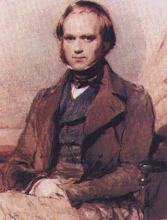
As Earth cooled from its molten origin, the earliest crust probably consisted of iron and magnesium-rich minerals, minerals that can crystallize at high temperatures. This assemblage of minerals forms the igneous rock basalt.
Once the Earth had cooled sufficiently for this initial crust to form, shifting plates of basaltic crust collided, one plate sinking back into the Earth’s mantle, causing the less dense minerals in the upper mantle such as quartz and feldspar, to melt, and forming a lighter, less-dense magma that erupted at the Earth’s surface in a chain of volcanoes, or island arc.
This is the same sort of tectonic activity that formed the Aleutian Islands and the islands of Japan, so we can picture the first landforms on Earth as chains of volcanic islands.
Continents would form later, as tectonic plates carrying these island arcs collided.
Illustration of a very young Earth from here.
More on early Earth from National Geographic.






















